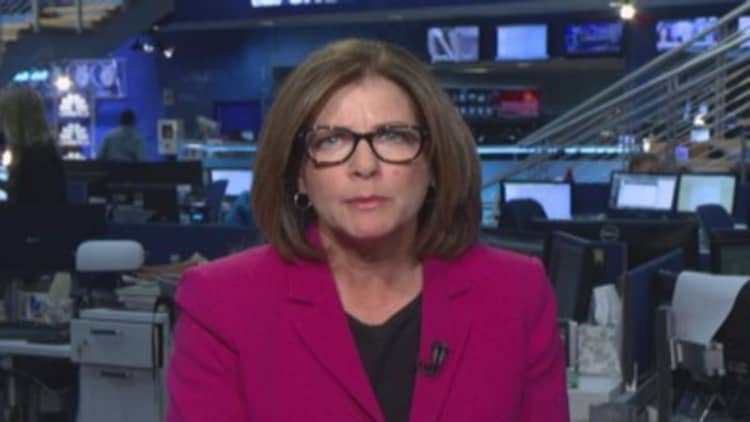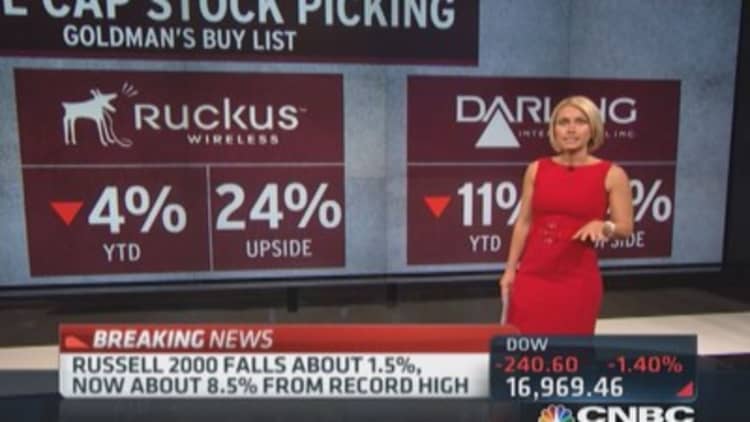
Friday's markets are expected to be volatile, as investors weigh whether this week's selloff is the start of a bigger pullback or just end-of-quarter profit-taking.
A negative for stocks Friday is the fact that key indices closed near the lows of the day Thursday, with all major industry sectors lower, while bonds and the dollar rose. The S&P 500 fell through its 50-day moving average—at 1,976—and fell to 1,966, a decline of 1.6 percent.
Economic reports expected Friday are second-quarter GDP at 8:30 a.m. EDT, expected to be revised to show increased growth of 4.6 percent, from 4.2 percent—a big spring back from the weather-impacted weak first quarter. Consumer sentiment is released at 9:55 a.m. and is expected to show improvement over last month.
Earnings are also due from Blackberry. But the market itself will likely be the big event, with traders scrutinizing the action to see if the market is finally getting poised to correct.
"I'm worried about tomorrow," said Art Cashin, director of floor operations at UBS. "This is historically the weakest week of the year for stocks. …This could be the beginning of one of those September–October things."
Read MoreCashin: What could be behind the selloff
Traders often point to seasonal performance of the market, where selling historically starts in August or September before the market bottoms out in October.
Cashin said there were a number of factors and rumors driving stocks, including one that a hedge fund was liquidating. "Selling was broad. Yesterday's rally was narrow ...These are all contributing factors. The market had to be ripe for it," Cashin said.
Scott Redler, who trades the markets short-term technicals with T3Live.com, said the market has been setting up for this selloff, and Friday's open will be telling.
Read MoreAs market sinks, fear surges—'feeling toppy'
"More traders would hope for a down open versus an up open, considering we closed weak," he said. "A healthier trade for the market would be futures down 10 to 12 handles versus gapping up 8 to 12 handles, which traders would probably look to sell."
He said the S&P needs to hold the 1,946 to 1,952 area, or it could retest lows closer to 1,900, set in August.
"Although it felt like a real negative day, the market is still in the midst of no man's land—below the 50-day moving average but just 3 percent off its highs and 60 points above its August lows. The sellers have the ball. If they can keep the S&P below the 50-day, chances are we could see more downside again until lower levels get tested. There's been some signals under the hood that the market hasn't been as healthy as it appeared, as far as the S&P is concerned," Redler said.
Traders pointed to varying reasons for the selling Thursday, but an overriding theme was the coming end of the Fed's quantitative easing program and the move to a more normal rate environment, at a time when global growth may be softening.
Read MoreHawks and Bears: Why the market is being mauled
Traders across financial markets, especially in foreign exchange, focused on a Wall Street Journal report about changes at the top of China's central bank, creating more uncertainty as China's economy continues to be weak.
A second report that a Russian draft law would allow the seizure of foreign assets spooked bonds and stocks, as traders speculated that such action would increase European economic weakness.
The Dow fell 264 points, or 1.5 percent to 16,945, and the Nasdaq lost 88 points—or 1.9 percent—to 4,466. The Russell 2000, fell 1.6 percent, thought it has led on the downside in recent weeks. The quarter end is Tuesday, and while stocks are lower for the month of September, they are generally higher for the quarter-to-date. The Dow is up about a half percent, and the is up 0.3 percent.

"Recently, there have been a number of divergences that have developed, where large caps continued to hold in and small caps did poorly. This is closing some of those divergences. It's clear some of this is related to the dollar and commodity prices and investors' fears about Europe and deflation there," said Gina Martin Adams, institutional portfolio strategist at Wells Fargo Securities.
The dollar index, meanwhile, rose to a four-year high as the euro slid to a near two-year low on expectations the European Central Bank will go further into easing mode as the Fed pulls back.
Read MoreToxic stew of factors drives stocks lower
Adams said the pending end of the Fed's bond buying program this fall leaves the market faced with uncertainty it hasn't seen during the period the Fed has conducted quantitative easing, while promising rate hikes far into the future. The time is getting closer for Fed rate hikes, and hawkish Dallas Fed President Richard Fisher reminded markets of that Thursday when he said the hikes could start in the spring, sooner than the consensus of June 2015.
The dollar has moved higher in recent weeks as traders look forward to higher interest rates. Commodities, like oil and gold, have fallen sharply as a result.
Read MoreWhy oil isn't spiking on Mideast fears: Gartman
"I think the Fed has created for themselves a situation that the market is generally very sensitive to every communication that comes out from the Fed. I wouldn't dismiss anything a Fed president says or a Fed speaker as potentially market moving. We are going to be in that environment until we have a much greater sense of what the end of QE means," Adams said. "When QE goes to zero, we can ultimately shed that and see how the market reacts."
Peter Boockvar, chief market analyst at Lindsey Group, said the Fed bond buying program may have been the catalyst. "At the end of QE, stuff happens. At the end of QE, the beer goggles come off. We've been leading up to this," he said. "We had the least amount of bears since 1987. This was an extraordinarily loved rally to the point where there weren't any bears."
Boocvkar said the rally Wednesday was a head fake, after two big down days earlier in the week. He said the Russell 2000 has been sending a warning.
"Damage is being done here. This is not your run of the mill little pull back because of the breadth of selling. This is more than a short-term thing," he said.


